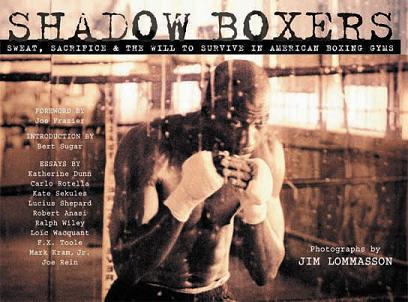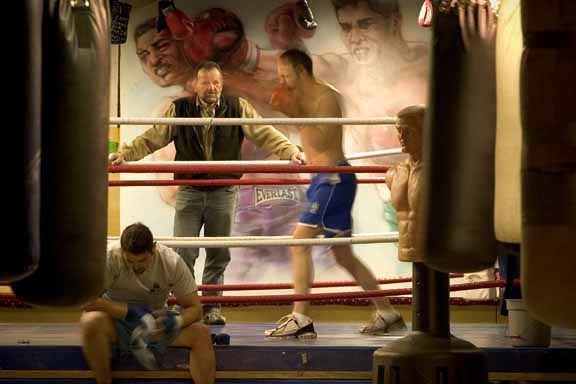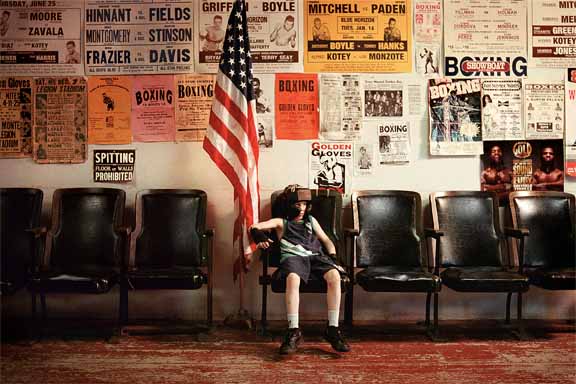February 2006
Rinsing Off the Mouthpiece
By GorDoom
Poem of the Month
By Tom Smario
The 2005 CBZ Year-End Awards
By J.D. Vena
Women to Watch For in 2006
By Adam
Pollack
INTERVIEWS:
Lou DiBella: No Joe Palooka
By Dave Iamaele
Lamon Brewster, Unplugged
By Juan C.
Ayllon
Touching Gloves with...
Clyde Gray
By Dan
Hanley
PROFILES:
Iron Mike Tyson: Myth or Monster?
By
Jim Trunzo
Jess Sandoval: The Coach Says,
"Bundle Up"
By
Katherine Dunn
The Legend of the Cuban Baron,
Ramon Castillo
By Enrique Encinsoa
Paul Thorn
By Pete Ehrman
Battling Nelson: Always Battered,
Seldom Beaten
By Tracy Callis
Kid Chocolate,
the Cuban Bon Bon
By Monte Cox
BOOK REVIEWS AND EXCERPTS:
Shadow Boxers
Photographs by Jim
Lommasson
The Iceman Diaries
by John Scully
The Boxing Bookshelf
by Dave Iamele
|

'Shadow Boxers'
Photographs by
Jim Lommasson
(Drag your mouse over each photograph to reveal the caption, and click for a larger view.)
You probably don't know the boxers in this book. Few if any have danced under the lights
of Madison Square Garden or Caesars Palace. They are the underdogs, the journeymen, the
rank and file of the fight game who toil in busted-out boxing gyms far from the television
cameras.
At one time there was a boxing gym in every sizable town in America. Today, they are
found mostly in big cities, tucked away in shabby lofts and basements in the tough parts
of town. Those that survive are the repositories of a centuries-old tradition of
pugilistic knowledge that encompasses not only the physical mechanics of the sport but a
code of respect and discipline that, at its best, transforms raw aggression into "sweet
science."
In Shadow Boxers: Sweat, Sacrifice & the Will to Survive in American Boxing Gyms,
photographer Jim Lommasson chronicles the tough -- and surprisingly tender -- world of
America's boxing gyms and the community of fighters, trainers, and hangers-on who inhabit
them. What he reveals to us is that boxing gyms are more than training facilities. They
are sanctuaries in bad neighborhoods, lifelines for troubled kids, and shrines to the
traditions of the sport.
 In addition to the photographs are more than 20 essays by a team of veteran boxing
writers: Katherine Dunn, best known for her novel Geek Love, discusses the role of
boxing gyms in tough urban communities and takes a poignant look at a kid's first boxing
lesson. Lucius Shepard, author of Viator and A Handbook of American Prayer,
explains how the rhythms and rituals of the gym transform a young street fighter into a
boxer. F.X. Toole, author of Rope Burns, a collection of short stories on which the
movie Million Dollar Baby is based, reflects on the magic and drama of the boxing
ring. Kate Sekules, a pioneering woman boxer and author of The Boxer's Heart,
explores the subject of female aggression and reports on the travails of getting ahead in
a male-dominated sport. Carlo Rotella, author of Cut Time: An Education at the
Fights, discusses how boxers learn their craft merely by watching other fighters.
In addition to the photographs are more than 20 essays by a team of veteran boxing
writers: Katherine Dunn, best known for her novel Geek Love, discusses the role of
boxing gyms in tough urban communities and takes a poignant look at a kid's first boxing
lesson. Lucius Shepard, author of Viator and A Handbook of American Prayer,
explains how the rhythms and rituals of the gym transform a young street fighter into a
boxer. F.X. Toole, author of Rope Burns, a collection of short stories on which the
movie Million Dollar Baby is based, reflects on the magic and drama of the boxing
ring. Kate Sekules, a pioneering woman boxer and author of The Boxer's Heart,
explores the subject of female aggression and reports on the travails of getting ahead in
a male-dominated sport. Carlo Rotella, author of Cut Time: An Education at the
Fights, discusses how boxers learn their craft merely by watching other fighters.
 Sociologist Loic Wacquant, author of Body & Soul: Notebooks of an Apprentice Boxer,
summons the sounds and pungent smells of the gym and the sense of camaraderie and shared
sacrifice that binds fighters together into a community. Robert Anasi, a former Golden
Gloves boxer and author of The Gloves, writes about the personal demons that drove
him to the gym. Joe Rein, a boxing writer and editor of FightWorld.us, advises the
Smithsonian Institution to snatch up one of the few remaining old-fashioned gyms and put
it in a museum before the last of these American institutions vanishes. The late Ralph
Wiley, a senior writer for Sports Illustrated and an ESPN commentator before his
death in 2004, recalls a visit to an Oakland gym, where he learned about the fundamentals
of boxing from a couple of old-time trainers. And sportswriter Mark Kram Jr. talks to a
promising young fighter about his thoughts and feelings before a bout at the legendary
Blue Horizon in Philadelphia.
Sociologist Loic Wacquant, author of Body & Soul: Notebooks of an Apprentice Boxer,
summons the sounds and pungent smells of the gym and the sense of camaraderie and shared
sacrifice that binds fighters together into a community. Robert Anasi, a former Golden
Gloves boxer and author of The Gloves, writes about the personal demons that drove
him to the gym. Joe Rein, a boxing writer and editor of FightWorld.us, advises the
Smithsonian Institution to snatch up one of the few remaining old-fashioned gyms and put
it in a museum before the last of these American institutions vanishes. The late Ralph
Wiley, a senior writer for Sports Illustrated and an ESPN commentator before his
death in 2004, recalls a visit to an Oakland gym, where he learned about the fundamentals
of boxing from a couple of old-time trainers. And sportswriter Mark Kram Jr. talks to a
promising young fighter about his thoughts and feelings before a bout at the legendary
Blue Horizon in Philadelphia.
 An introduction by acclaimed boxing writer Bert Sugar (who will be inducted into the
Boxing Hall of Fame in June) traces the history of boxing gyms. In the foreword, former
world heavyweight champion Joe Frazier recalls his early days in a scruffy PAL gym in
Philadelphia and talks about the principles that guide his own gym today.
An introduction by acclaimed boxing writer Bert Sugar (who will be inducted into the
Boxing Hall of Fame in June) traces the history of boxing gyms. In the foreword, former
world heavyweight champion Joe Frazier recalls his early days in a scruffy PAL gym in
Philadelphia and talks about the principles that guide his own gym today.
Jim Lommasson and Katherine Dunn were awarded the 2004 Dorothea Lange-Paul Taylor Prize by
the Center for Documentary Studies at Duke University for their collaboration on this
book.
ABOUT THE PHOTOGRAPHER
 Jim Lommasson is a photographer based in Portland, Oregon. He and writer Katherine
Dunn were awarded the 2004 Dorothea Lange-Paul Taylor Prize by the Center for Documentary
Studies at Duke University for their collaboration on this book. Lommasson is a two-time
winner of the New York Art Directors Award and was named Person of the Year by Media Inc.
and the American Marketing Association. He exhibits his work throughout the United States.
He has been documenting boxing gyms for more than a decade.
Jim Lommasson is a photographer based in Portland, Oregon. He and writer Katherine
Dunn were awarded the 2004 Dorothea Lange-Paul Taylor Prize by the Center for Documentary
Studies at Duke University for their collaboration on this book. Lommasson is a two-time
winner of the New York Art Directors Award and was named Person of the Year by Media Inc.
and the American Marketing Association. He exhibits his work throughout the United States.
He has been documenting boxing gyms for more than a decade.
ABOUT THE WRITERS
 Robert Anasi, a
former Golden Gloves boxer, is the author of The Gloves: A Boxing Chronicle.
Robert Anasi, a
former Golden Gloves boxer, is the author of The Gloves: A Boxing Chronicle.
Rene Denfeld trained as an amateur boxer and is the author of Kill the Body, the
Head Will Fall: A Closer Look at Women, Violence, and Aggression.
Katherine Dunn is the author of Geek Love, a finalist for the National Book
Award in 1989. She has been covering boxing since 1980, and her writing on the sport has
appeared in such publications as The Ring, KO, Boxing Today, Esquire, Interview, Mother
Jones, Vogue, The New York Times Sunday Magazine, Sports Illustrated for Women, and
Playboy. She is associate editor of CyberBoxingZone.com.
 Joe Frazier is a former world heavyweight champion. A gold medalist at the 1964
Olympic Games and a member of the Boxing Hall of Fame, he works with professional and
amateur fighters at Smokin' Joe Frazier's Gym in Philadelphia and oversees Frazier's
Golden Gloves youth program.
Joe Frazier is a former world heavyweight champion. A gold medalist at the 1964
Olympic Games and a member of the Boxing Hall of Fame, he works with professional and
amateur fighters at Smokin' Joe Frazier's Gym in Philadelphia and oversees Frazier's
Golden Gloves youth program.
Joe Rein is executive editor of FightWorld.us and a freelance writer.
Mark Kram Jr. has been a sportswriter for the Philadelphia Daily News since
1987. His work has appeared in The Best American Sports Writing in 1993, 2002, and
2003.
 Carlo Rotella is the author of Cut Time: An Education at the Fights, which
received the L.L. Winship/PEN New England Award and was a finalist for the Los Angeles
Times Book Prize. He contributes regularly to the Washington Post Magazine and
The American Scholar. His writing about boxing has appeared in Harper's,
DoubleTake, and Best American Essays. He is director of American Studies and
associate professor of English at Boston College.
Carlo Rotella is the author of Cut Time: An Education at the Fights, which
received the L.L. Winship/PEN New England Award and was a finalist for the Los Angeles
Times Book Prize. He contributes regularly to the Washington Post Magazine and
The American Scholar. His writing about boxing has appeared in Harper's,
DoubleTake, and Best American Essays. He is director of American Studies and
associate professor of English at Boston College.
Kate Sekules is the author of The Boxer's Heart: Lessons from the Ring. She
is a contributing editor at Food & Wine magazine, and her work has appeared in such
publications as Travel & Leisure, O, Vogue, The New Yorker, and Harper's
Bazaar.
Lucius Shepard writes about boxing for CNN/Sports Illustrated and CyberBoxingZone.
com. His novels include A Handbook of American Prayer and VIATOR.
 Bert Randolph Sugar is former editor of The Ring, Boxing Illustrated, and
Fight Game and is the author of more than 50 books, including Bert Sugar on
Boxing. He was named the "Greatest Boxing Writer of All Time" by the International
Veteran Boxers Association. He was inducted into the Boxing Hall of Fame in June
2005.
Bert Randolph Sugar is former editor of The Ring, Boxing Illustrated, and
Fight Game and is the author of more than 50 books, including Bert Sugar on
Boxing. He was named the "Greatest Boxing Writer of All Time" by the International
Veteran Boxers Association. He was inducted into the Boxing Hall of Fame in June
2005.
Loic Wacquant is professor of sociology at the University of California, Berkeley,
and researcher at the Centre de Sociologie Europeenne du College de France. He is the
author of Body & Soul: Notebooks of an Apprentice Boxer and held a MacArthur
Foundation fellowship.
F.X. Toole was a cut man for more than 20 years. His collection of short stories,
Rope Burns: Stories from the Corner, was adapted for the film Million Dollar
Baby. He died in 2002.
Ralph Wiley served as a senior writer for Sports Illustrated, a commentator
on ESPN's SportsCenter, and a columnist for ESPN.com before his death at the age of 52 in
2004. He wrote articles for GQ, National Geographic, Premiere, and many national
newspapers. His books include Serenity: A Boxing Memoir.
PRAISE FOR SHADOW BOXERS
 "When I look at Jim Lommasson's pictures, I see myself as a young man working out day
after day in that little PAL gym in Philadelphia, where my career started. This book shows
a side of boxing that most people don't see -- the dedication and discipline that it takes
to be a champion in the ring and in life."
"When I look at Jim Lommasson's pictures, I see myself as a young man working out day
after day in that little PAL gym in Philadelphia, where my career started. This book shows
a side of boxing that most people don't see -- the dedication and discipline that it takes
to be a champion in the ring and in life."
-- Joe Frazier, from the Foreword
"A triumphal procession of words and pictures such as no Roman emperor ever dreamed of.
This is a book truly for those with a reverence for the traditions of the sport."
--
Bert Sugar, from the Introduction
"An insider's vivid, surprising look at a world most of us never get a chance to see -- a
world of battle-weary veterans and bright-eyed newcomers, of surrogate fathers and ancient
skills and sanctuary from the mean streets just outside the door. Not to be missed."
-- Geoffrey C. Ward, author of Unforgivable Blackness: The Rise and Fall of Jack
Johnson
"Gritty, grimy, and gorgeous. Lommasson's images move beyond the easy, one-sided spectacle
of boxing as a blood sport and toward a multifaceted depiction of the boxing gym as a
unique and beloved American institution. Visceral and quietly dramatic, the photos are
[...] a lively cross-breed of art and journalism."
-- Victoria Blake, The
Oregonian, review of gallery exhibition.
"As these gyms disappear...the essays...and photographs brought together in this
documentary will provide a valuable portrait of this historic American institution."
-- The Center for Documentary Studies at Duke University
> contents
<
|

